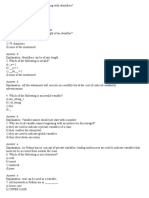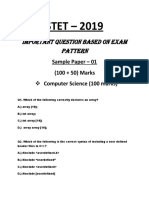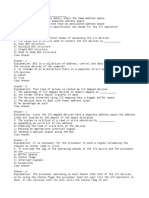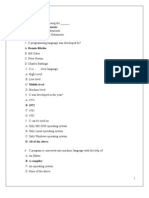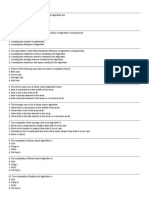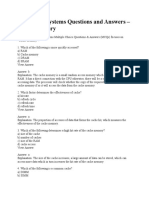0 ratings0% found this document useful (0 votes)
432 viewsAutomata Theory Questions and Answers - Finite Automata: GJHGHJ
Automata Theory Questions and Answers - Finite Automata: GJHGHJ
Uploaded by
Kamalakar SreevatasalaThis document provides 15 multiple choice questions about finite automata. Some key points covered include:
- There are 5 tuples in a finite state machine: states, input symbols, initial state, accepting state, and transition function.
- The transition function maps states and input strings to an output state.
- A minimal finite automaton with 3 states is required to accept strings that end with "10".
- The language of a finite automaton is the set of strings that are accepted by the automaton.
- Finite automata have limitations in that they cannot remember arbitrary large amounts of information like pushdown automata or Turing machines.
Copyright:
© All Rights Reserved
Available Formats
Download as DOCX, PDF, TXT or read online from Scribd
Automata Theory Questions and Answers - Finite Automata: GJHGHJ
Automata Theory Questions and Answers - Finite Automata: GJHGHJ
Uploaded by
Kamalakar Sreevatasala0 ratings0% found this document useful (0 votes)
432 views5 pagesThis document provides 15 multiple choice questions about finite automata. Some key points covered include:
- There are 5 tuples in a finite state machine: states, input symbols, initial state, accepting state, and transition function.
- The transition function maps states and input strings to an output state.
- A minimal finite automaton with 3 states is required to accept strings that end with "10".
- The language of a finite automaton is the set of strings that are accepted by the automaton.
- Finite automata have limitations in that they cannot remember arbitrary large amounts of information like pushdown automata or Turing machines.
Original Description:
theory of automata
Original Title
Toa
Copyright
© © All Rights Reserved
Available Formats
DOCX, PDF, TXT or read online from Scribd
Share this document
Did you find this document useful?
Is this content inappropriate?
This document provides 15 multiple choice questions about finite automata. Some key points covered include:
- There are 5 tuples in a finite state machine: states, input symbols, initial state, accepting state, and transition function.
- The transition function maps states and input strings to an output state.
- A minimal finite automaton with 3 states is required to accept strings that end with "10".
- The language of a finite automaton is the set of strings that are accepted by the automaton.
- Finite automata have limitations in that they cannot remember arbitrary large amounts of information like pushdown automata or Turing machines.
Copyright:
© All Rights Reserved
Available Formats
Download as DOCX, PDF, TXT or read online from Scribd
Download as docx, pdf, or txt
0 ratings0% found this document useful (0 votes)
432 views5 pagesAutomata Theory Questions and Answers - Finite Automata: GJHGHJ
Automata Theory Questions and Answers - Finite Automata: GJHGHJ
Uploaded by
Kamalakar SreevatasalaThis document provides 15 multiple choice questions about finite automata. Some key points covered include:
- There are 5 tuples in a finite state machine: states, input symbols, initial state, accepting state, and transition function.
- The transition function maps states and input strings to an output state.
- A minimal finite automaton with 3 states is required to accept strings that end with "10".
- The language of a finite automaton is the set of strings that are accepted by the automaton.
- Finite automata have limitations in that they cannot remember arbitrary large amounts of information like pushdown automata or Turing machines.
Copyright:
© All Rights Reserved
Available Formats
Download as DOCX, PDF, TXT or read online from Scribd
Download as docx, pdf, or txt
You are on page 1of 5
Gjhghj
Automata Theory Questions and Answers Finite Automata
This set of Automata Theory Multiple Choice Questions & Answers (MCQs) focuses on
Regular Language & Expression.
1. There are ________ tuples in finite state machine.
a) 4
b) 5
c) 6
d) unlimited
View Answer
Answer:b
Explanation: states,input symbols,initial state,accepting state and transition function.
2. Transition function maps.
a) * Q ->
b) Q * Q ->
c) * -> Q
d) Q * -> Q
View Answer
Answer:d
Explanation: Inputs are state and input string output is states.
3. Number of states require to accept string ends with 10.
a) 3
b) 2
c) 1
d) cant be represented.
View Answer
Answer:a
Explanation: This is minimal finite automata.
4. Extended transition function is .
a) Q * * -> Q
b) Q * -> Q
c) Q* * * ->
d) Q * ->
View Answer
Answer:a
Explanation: This takes single state and string of input to produce a state.
5. *(q,ya) is equivalent to .
a) ((q,y),a)
b) (*(q,y),a)
c) (q,ya)
d) independent from notation
View Answer
Answer:b
Explanation: First it parse y string after that it parse a.
6. String X is accepted by finite automata if .
a) *(q,x) E A
b) (q,x) E A
c) *(Q0,x) E A
d) (Q0,x) E A
View Answer
Answer:c
Explanation: If automata starts with starting state and after finite moves if reaches to final step then it
called accepted.
7. Languages of a automata is
a) If it is accepted by automata
b) If it halts
c) If automata touch final state in its life time
d) All language are language of automata
View Answer
Answer:a
Explanation: If a string accepted by automata it is called language of automata.
8. Language of finite automata is.
a) Type 0
b) Type 1
c) Type 2
d) Type 3
View Answer
Answer:d
Explanation: According to Chomsky classification.
9. Finite automata requires minimum _______ number of stacks.
a) 1
b) 0
c) 2
d) None of the mentioned
View Answer
Answer:b
Explanation: Finite automata doesnt require any stack operation .
10. Number of final state require to accept in minimal finite automata.
a) 1
b) 2
c) 3
d) None of the mentioned
View Answer
Answer:d
Explanation: No final state requires.
11. Regular expression for all strings starts with ab and ends with bba is.
a) aba*b*bba
b) ab(ab)*bba
c) ab(a+b)*bba
d) All of the mentioned
View Answer
Answer:c
Explanation: Starts with ab then any number of a or b and ends with bba.
12. How many DFAs exits with two states over input alphabet {0,1} ?
a) 16
b) 26
c) 32
d) 64
View Answer
Answer:d
Explanation: Number of DFAs = 2^n * n^(2*n).
13. The basic limitation of finite automata is that
a) It cant remember arbitrary large amount of information.
b) It sometimes recognize grammar that are not regular.
c) It sometimes fails to recognize regular grammar.
d) All of the mentioned
View Answer
Answer:a
Explanation:Because there is no memory associated with automata.
14. Number of states require to simulate a computer with memory capable of storing 3
words each of length 8.
a) 3 * 2^8
b) 2^(3*8)
c) 2^(3+8)
d) None of the mentioned
View Answer
Answer:b
Explanation: 2^(m*n) states requires .
15. FSM with output capability can be used to add two given integer in binary
representation. This is
a) True
b) False
c) May be true
d) None of the mentioned
View Answer
Answer:a
Explanation: Use them as a flip flop output .
You might also like
- OS Question BankDocument62 pagesOS Question Bankriya.samantaray2021No ratings yet
- CSE211 MCQ'sDocument17 pagesCSE211 MCQ'sYash Gupta Maurya100% (1)
- C Mcq-Unit-IDocument91 pagesC Mcq-Unit-Igdeepthi100% (1)
- PythonDocument126 pagesPythonATUL SHARMANo ratings yet
- PPSC Computer Science Lecturer 2015 (68 Question With Answer)Document9 pagesPPSC Computer Science Lecturer 2015 (68 Question With Answer)farwa jabinNo ratings yet
- QuestionsDocument18 pagesQuestionsPrerak DedhiaNo ratings yet
- Thread MCQsDocument7 pagesThread MCQsDisha ThoratNo ratings yet
- Compiler Design MCQ Question Bank Last Update 29-Dec-20202 Page 1 of 18Document18 pagesCompiler Design MCQ Question Bank Last Update 29-Dec-20202 Page 1 of 18SOMENATH ROY CHOUDHURYNo ratings yet
- C++ MCQ DaccDocument50 pagesC++ MCQ DaccSantosh PhatangareNo ratings yet
- Cs 503 - Design & Analysis of Algorithm: Multiple Choice QuestionsDocument3 pagesCs 503 - Design & Analysis of Algorithm: Multiple Choice QuestionsSheikh ShabirNo ratings yet
- Microprocessor MCQ: For 4th Sem MCQ: For 6th Sem MCQDocument24 pagesMicroprocessor MCQ: For 4th Sem MCQ: For 6th Sem MCQKiran RajputNo ratings yet
- Computer Architecture MCQ SDocument19 pagesComputer Architecture MCQ SAbdulRehmanNo ratings yet
- Advanced Java Questions MCQ 2 PDFDocument102 pagesAdvanced Java Questions MCQ 2 PDFadithyata6No ratings yet
- MCQDocument3 pagesMCQmanaliNo ratings yet
- Topic Wise MCQ of Operating SystemsDocument27 pagesTopic Wise MCQ of Operating SystemsRuba Niazi100% (1)
- STET - 2019: Important Question Based On Exam PatternDocument42 pagesSTET - 2019: Important Question Based On Exam PatternAtul Prakash DwivediNo ratings yet
- Bca 501 Computer NetworksDocument19 pagesBca 501 Computer NetworksManuja Maniyan100% (1)
- Web Technology (Chapter - Website Design) Solved MCQs (Set-1) PDFDocument6 pagesWeb Technology (Chapter - Website Design) Solved MCQs (Set-1) PDFDINESHWARAN MNo ratings yet
- DCN BitsDocument489 pagesDCN Bitskuderu harshithaNo ratings yet
- Coa MCQ PDFDocument25 pagesCoa MCQ PDFSaumya JoshiNo ratings yet
- Computer Science MCQsDocument14 pagesComputer Science MCQsMuhammad Sikandar DarNo ratings yet
- Unit 5 MCQDocument15 pagesUnit 5 MCQ30. Suraj IngaleNo ratings yet
- Dbms McqsDocument5 pagesDbms McqsShweta Sharma100% (2)
- Computer Organisation and Architecture MCQ Part 1Document5 pagesComputer Organisation and Architecture MCQ Part 1Vimeno Dolie100% (1)
- Operating System Questions & Answers - CPU SchedulingDocument12 pagesOperating System Questions & Answers - CPU SchedulingJames TempletonNo ratings yet
- C++ MCQDocument24 pagesC++ MCQAnonymous ZyJUVB3fzxNo ratings yet
- Compiler MCQ (MCA 504A)Document23 pagesCompiler MCQ (MCA 504A)swarup sarkarNo ratings yet
- Typical Questions & AnswersDocument82 pagesTypical Questions & AnswersSudip PaulNo ratings yet
- Software Engineering MCQsDocument3 pagesSoftware Engineering MCQsfahad81pk50% (2)
- Software Engineering ObjectiveDocument5 pagesSoftware Engineering Objectivebheemsinghsaini100% (1)
- Object Oriented Programming Questions and Answers - Classes: StudentDocument5 pagesObject Oriented Programming Questions and Answers - Classes: Studentbc170401540 MUHAMMAD SHAHID100% (1)
- Computer Science (Fe) Mcq'sDocument41 pagesComputer Science (Fe) Mcq'scutyverma100% (1)
- Dsa MCQDocument9 pagesDsa MCQbenaminsan100% (1)
- Fundamentals of Data Structures - MCQ - III.Document22 pagesFundamentals of Data Structures - MCQ - III.Jeya Perumal100% (1)
- Unit I MCQDocument7 pagesUnit I MCQSasi BhushanNo ratings yet
- Internet of Things (IoT) Solved MCQs (Set-3)Document5 pagesInternet of Things (IoT) Solved MCQs (Set-3)Shweta KachawarNo ratings yet
- 100 TOP C Language Multiple Choice Questions and Answers - Multiple Choice Questions and Answers Beginners and Experienced PDFDocument18 pages100 TOP C Language Multiple Choice Questions and Answers - Multiple Choice Questions and Answers Beginners and Experienced PDFAvinash Rao33% (3)
- Digital Electronics and Logic Design Solved MCQs (Set-20)Document8 pagesDigital Electronics and Logic Design Solved MCQs (Set-20)KunalNo ratings yet
- Software Engineering MCQ'SDocument15 pagesSoftware Engineering MCQ'SGuruKPO100% (2)
- Data Structure MCQ (Multiple Choice Questions) - SanfoundryDocument15 pagesData Structure MCQ (Multiple Choice Questions) - SanfoundryEzekiel JamesNo ratings yet
- C++ Ques For Practice PDFDocument41 pagesC++ Ques For Practice PDFMohammad Annus100% (1)
- Compiler Counstruction MCQ Question Bank PDFDocument14 pagesCompiler Counstruction MCQ Question Bank PDFJH. channelNo ratings yet
- DS ALL MCQsDocument196 pagesDS ALL MCQsnilesh gagare100% (1)
- Data Structures MCQDocument37 pagesData Structures MCQchaudhari ManishNo ratings yet
- Coa MCQ PDFDocument47 pagesCoa MCQ PDFKeerthika100% (1)
- Visual Basic Programming Question Paper For InstituteDocument8 pagesVisual Basic Programming Question Paper For InstituteKeshav SonkusareNo ratings yet
- 300+ TOP Computer Organization & Architecture MCQs and Answers 2023Document41 pages300+ TOP Computer Organization & Architecture MCQs and Answers 2023Natanem YimerNo ratings yet
- Fundamentals of Data Structures - MCQ - IIDocument34 pagesFundamentals of Data Structures - MCQ - IIJeya Perumal100% (1)
- MCQs On Cache MemoriesDocument5 pagesMCQs On Cache MemoriesAkhil PalleNo ratings yet
- IBPS IT Officer Model Questions DBMS MCQ QuestionsDocument7 pagesIBPS IT Officer Model Questions DBMS MCQ QuestionsNshant KrNo ratings yet
- C++ (C Plus Plus) MCQ: Multiple Choice Questions and AnswersDocument10 pagesC++ (C Plus Plus) MCQ: Multiple Choice Questions and Answersfarhan100% (3)
- CN 1st Unit MCQ 200Document39 pagesCN 1st Unit MCQ 200Mohanaprakash Ece100% (1)
- DBMS MCQDocument9 pagesDBMS MCQsamlakshiaNo ratings yet
- Computer Organization - Functional Units of A ComputerDocument31 pagesComputer Organization - Functional Units of A ComputerKiruthiga PrabakaranNo ratings yet
- TOC MCQsDocument84 pagesTOC MCQsAnonymous NoLC1bXCNo ratings yet
- Automata Theory Questions and AnswersDocument58 pagesAutomata Theory Questions and Answerstamirat86% (14)
- Automata Theory Questions and AnswersDocument55 pagesAutomata Theory Questions and Answerstamirat100% (4)
- TOC (CS-501) Question Bank AND MCQDocument7 pagesTOC (CS-501) Question Bank AND MCQshubh agrawal88% (8)
- TOC Merged FinalDocument3,971 pagesTOC Merged FinalHii There50% (2)
- File Processing System and Its DisadvantagesDocument6 pagesFile Processing System and Its DisadvantagesKamalakar SreevatasalaNo ratings yet
- Photo Shop LabDocument10 pagesPhoto Shop LabKamalakar SreevatasalaNo ratings yet
- 09 Chapter 1Document47 pages09 Chapter 1Kamalakar SreevatasalaNo ratings yet
- Architectural Framework For Electronic CommerceDocument3 pagesArchitectural Framework For Electronic CommerceKamalakar Sreevatasala60% (5)
- BFSDocument1 pageBFSKamalakar SreevatasalaNo ratings yet
- Maximum Likelihood Estimation - StokastikDocument8 pagesMaximum Likelihood Estimation - StokastikKamalakar SreevatasalaNo ratings yet
- 1./ C Program To Find The Given Number Is Perfect Number or NotDocument10 pages1./ C Program To Find The Given Number Is Perfect Number or NotKamalakar SreevatasalaNo ratings yet
- Frequent Item-Set Mining Methods: Prepared By-Mr - Nilesh MagarDocument31 pagesFrequent Item-Set Mining Methods: Prepared By-Mr - Nilesh MagarKamalakar SreevatasalaNo ratings yet
- Basic Features of Unix Operating SystemDocument50 pagesBasic Features of Unix Operating SystemKamalakar Sreevatasala67% (3)
- Sales and Inventory Management SystemDocument22 pagesSales and Inventory Management SystemKamalakar Sreevatasala100% (1)
- Computer BooksDocument2 pagesComputer BooksKamalakar SreevatasalaNo ratings yet
- Application Form FULL GT June2016Document20 pagesApplication Form FULL GT June2016Kamalakar SreevatasalaNo ratings yet
- ., (Computers) Structure & Syllabi 5.7. 2016Document62 pages., (Computers) Structure & Syllabi 5.7. 2016Kamalakar SreevatasalaNo ratings yet
- E Ommerce Notes PDFDocument35 pagesE Ommerce Notes PDFRoop Ch Jha75% (4)
- Rand PDocument38 pagesRand PKamalakar SreevatasalaNo ratings yet
- Guideline For Devlop Grant To CollegesDocument24 pagesGuideline For Devlop Grant To CollegesKamalakar SreevatasalaNo ratings yet
- Think Python - Answers - Wikibooks, Open Books For An Open WorldDocument27 pagesThink Python - Answers - Wikibooks, Open Books For An Open WorldPetalPauloNo ratings yet
- MySQL CommandDocument7 pagesMySQL CommandNur RaihanNo ratings yet
- Programming in C N20 R15 2131Document3 pagesProgramming in C N20 R15 2131Sreekanth KuNo ratings yet
- Design and Analysis of AlgorithmsDocument23 pagesDesign and Analysis of Algorithmsgopelaw218No ratings yet
- Paper 1Document4 pagesPaper 1guna gouthamNo ratings yet
- Correction Multi-CoucheDocument20 pagesCorrection Multi-CoucheSamy NaifarNo ratings yet
- PHP MySQL in Easy Steps 2nd Edition TOCCh1Document22 pagesPHP MySQL in Easy Steps 2nd Edition TOCCh1alibasajonelNo ratings yet
- Session 3Document42 pagesSession 3Elakkiya KarthicNo ratings yet
- The Finite Element Method Using MATLAB - Kwon and BangDocument527 pagesThe Finite Element Method Using MATLAB - Kwon and BangRajeuv Govindan50% (4)
- Timing Correlation With PT OfficialDocument1 pageTiming Correlation With PT OfficialYongwoo KimNo ratings yet
- Ug903 Vivado Using Constraints en Us 2022.2Document197 pagesUg903 Vivado Using Constraints en Us 2022.2Tamil Selvan RangaNo ratings yet
- Creating ProceduresDocument5 pagesCreating ProceduresCatalina AchimNo ratings yet
- Mini Project C++ UITMDocument12 pagesMini Project C++ UITM2021816376No ratings yet
- FORTRAN90 - Practical Exercises: Session - 1Document3 pagesFORTRAN90 - Practical Exercises: Session - 1Ahmad AbbaNo ratings yet
- Spark 4.0Document123 pagesSpark 4.0shubhamkapadnis770No ratings yet
- Starting Out With C++ ProgrammingDocument14 pagesStarting Out With C++ Programmingmudassar bajwaNo ratings yet
- Semester 1 FinalDocument29 pagesSemester 1 FinalBudi NugrohoNo ratings yet
- Modicon M221 Logic Controllers: Catalog JanuaryDocument35 pagesModicon M221 Logic Controllers: Catalog JanuaryПавелNo ratings yet
- Microsoft Source ServerDocument19 pagesMicrosoft Source ServeribmmasterNo ratings yet
- Opcsbar UserefDocument176 pagesOpcsbar Useref无名No ratings yet
- Information Systems For Business and BeyondDocument343 pagesInformation Systems For Business and Beyondmohamed fayezNo ratings yet
- Can U Declare Multiple Heading Sections in One SQR Program?Document5 pagesCan U Declare Multiple Heading Sections in One SQR Program?Siji SurendranNo ratings yet
- V. Rajaraman, C. Siva Ram Murthy - Parallel Computers Architecture and Programming-PHI (2016)Document506 pagesV. Rajaraman, C. Siva Ram Murthy - Parallel Computers Architecture and Programming-PHI (2016)Google User100% (2)
- Primary Key GuidelinesDocument4 pagesPrimary Key Guidelinesapi-267086420No ratings yet
- Detailed Explanation About BADI and The Ways To Find The BADI With An Example (ME23n Transaction)Document14 pagesDetailed Explanation About BADI and The Ways To Find The BADI With An Example (ME23n Transaction)shrirangkattiNo ratings yet
- The Buildroot User ManualDocument126 pagesThe Buildroot User ManualCRISTIAN STIVEN ALMANZAR OROZCONo ratings yet
- Walkthrough - Creating and Using A Dynamic Link Library (C++)Document7 pagesWalkthrough - Creating and Using A Dynamic Link Library (C++)euuqduqrNo ratings yet
- PART C DSCDocument7 pagesPART C DSCkashokkumar sctengNo ratings yet
- Java Notes 2024Document83 pagesJava Notes 2024justcallmemrx9No ratings yet
- Code OptimizationDocument25 pagesCode OptimizationrizankyuNo ratings yet



